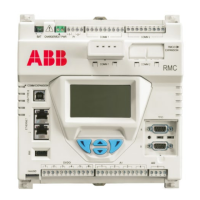26 | RMC-100| 2105552MNAE
2.2.9 Super capacitor
The RMC design includes an onboard super capacitor (Super CAP) that serves as a short-term power
reservoir. In the event of a loss of power or a reset, the charged capacitor prevents the supply voltage
from falling to zero for 2.5 seconds. This delay allows the system time to save data, such as trending
files, and restart configuration. The capacitor charges automatically when the controller is powered on
for the first time, or after the controller is powered off for several hours or longer. The capacitor
remains charged as long as the controller is powered on. The capacitor takes two minutes to charge.
2.3 Embedded software and data
The RMC non-volatile memory contains the software required for operation and provides storage
space for customer data.
The embedded software has the following components:
– Operating system: Required for system boot, operation, and execution of all applications
– Applications: Totalflow applications that define the RMC functions for the required scenarios
– Configuration: Files that contain factory default and user-defined settings and parameters
required by the applications active on the RMC
The stored customer data consists of all the data generated by each of the active applications, such as
the measurement data from the gas orifice application (AGA-3 tube). Stored data depends on the
configured applications for the specific site requirements.
2.3.1 Operating system
The RMC uses a thread-priority preemptive real-time operating system (Linux-based OS). The
software architecture prioritizes real-time functionality (measurement and control applications) before
executing non-real-time functions (post measurement data processing and file system access). The
RMC OS supports:
– Execution of the entire XSeries
G4
and XSeries
G5
suite of applications
– Backward-compatible protocol transactions for all applications
– Battery condition metering
– Improved real-time performance metrics
The OS file system has a RAM file system and an eMMC (embedded multimedia card) data journaling
file system. The applications access the RAM file system, which provides increased performance. The
RAM file system is backed up into the eMMC file system at the following triggers:
– Once a minute at the fourth second of each minute
– Prior to all warm restarts (triggered from PCCU Station Setup, terminal mode, the device loader,
or the reset button)
2.3.2 Applications
The RMC supports all XSeries
G4
and XSeries
G5
applications. All applications have real-time
performance metrics that monitor the overall health of the system.
2.3.2.1 Supported applications on the RMC
Table 2-14
identifies the applications for use in the United States (US) or internationally (SU).
The US and SU identifiers indicate units of measurements for the United
and the International System respectively. Please note that sometimes applications will
in the Application and Licensing Management Add App or App Info lists
what units are active in the system. Factory configurations tailor a system for
either SU or US units and
the system displays the appropriate app name for that configuration.
device is configured for US units, the name of the app is “AGA-3
”. When the device is configured for SU units, the name shows as “Gas Orifice SU”.
Names on the application lists may change once they display on the
PCCU navigation tree after
To view the most up-to-date RMC supported applications:
1. Connect the laptop or PC to one of the local ports on the RMC.
2. Launch PCCU and click Entry to connect with the controller in Entry mode.

